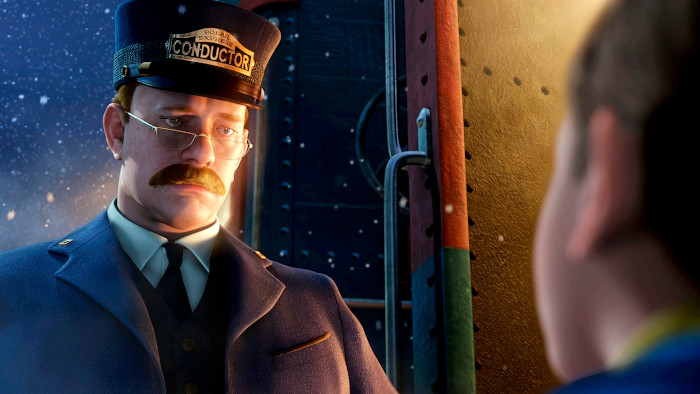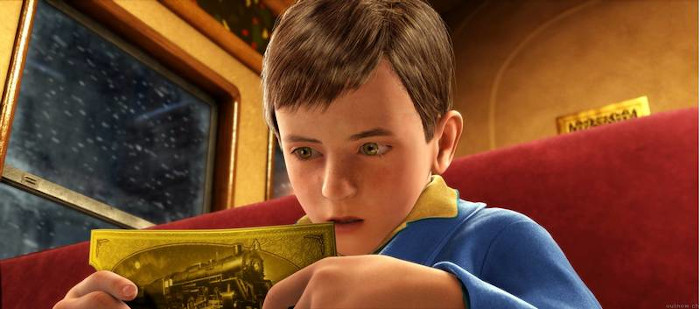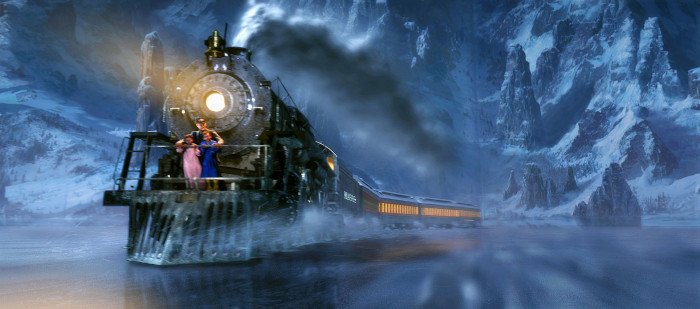The Polar Express was the first of series of films directed by Robert Zemeckis in which he (the others were Beowulf (2007), A Christmas Carol (2009) and, after more than a decade away, the Disney remake of Pinocchio (2022)) which used motion-captured footage of actors to create computer-generated images (the technique that Peter Jackson had refined for Gollum in the Lord of the Rings trilogy), a bit like a digital version of rotoscoping. According to The Guinness Book of Records, it’s the first film to be made entirely with digital capture in this way. The effect is sometimes disconcerting (the “uncanny valley” effect is unavoidable) but it’s Zemeckis’ best use of the technique thus far and has established itself as a festive go-to for almost two decades.
It’s Christmas Eve in Grand Rapids, Michigan, and a young boy who has lost his belief in Santa Claus. That night, a huge steam train named The Polar Express pulls up outside (a beautifully shot moment). The conductor (Tom Hanks who provides the voice and the motion capture performance) invites him aboard and he meets and befriends a young girl (Nona Gaye’s voice, Tinashe’s performance), a nerdy know-it-all (Eddie Deezen) and a shy, introverted boy named Billy (Peter Scolari). After various hair-raising adventures inside, on top of and outside the train, including an encounter with a magical hobo (Hanks again), narrowly avoiding disaster on a frozen lake and an encounter with a herd or caribou, the boy and his fellow passengers arrive at the North Pole where one of the passengers will be given the first gift of Christmas from Santa (also Hanks) himself.

Hanks had bought the rights to Chris Van Allsburg’s 1985 children’s book as early as 1999 (Van Allsburg also wrote the books that Jumanji (1995) and Zathura: A Space Adventure (2005) were based on) with a view to playing the conductor and Santa Claus (he was originally slated to play every character in the film but after early tests proved exhausting, he whittled it down to just five) and agreed with Zemeckis’ insistence that the film be animated, a medium that Van Allsburg didn’t seem too keen on. Although the film sometimes has that vaguely queasy quality that comes with the “uncanny valley” effect, the use of actors as models wins through and by the end you barely notice the effect at all.
Hanks (who had previously worked with Zemeckis on Forrest Gump (1994) and Cast Away (2000)) is, of course, marvellous as the mysterious conductor and his giant Santa has a genuine mystical quality about him that so few other films ever manage to capture. There’s no attempt at an origin tale or a back story – he’s just presented as an imposing force of nature to terrific effect. Indeed, the entire film, scripted by Zemeckis and William Broyles Jr, does away with any kind of simplistic and annoying explanations for what’s going on. We, like the young heroes, we just accept that The Polar Express is a real thing and they, like us, need no explanation for it at all. The story doesn’t even bother to give it’s two main young protagonists names – they’re just “hero boy” and hero girl” in the end credits.

It’s a film full of beautiful and surprising moments even if, in the end, it doesn’t really amount to all that much. But those moments are unforgettable – the sudden onslaught of singing and dancing waiters aboard the train, the first appearance of Santa, barely glimpsed as an indistinct figure in the crowd and most breath-taking of all, the short but extraordinary journey of a lost railway ticket, a scene reminiscent of that feather at the start and end of Forrest Gump. Often surreal, sometimes even nightmarish (that train car full of discarded and unwanted toys is as creepy as it gets), The Polar Express runs out of steam slightly when the train reaches its final destination but it’s an exhilarating ride up until then, and it cannily avoids much of the treacly sentimentality that often mars Hollywood’s festive efforts. There are, one might argue, a few too many set-pieces that feel like trailers for forthcoming computer games but at least it keeps things bubbling along nicely such that its 100 minutes doesn’t feel like it outstays its welcome at all. Even the inevitable songs are well-integrated.
For all its digital technology – and make no mistake, it really is an extraordinary feat – The Polar Express feels pleasingly old-fashioned. For some, the trip down the “uncanny valley” proves too unsettling but it takes us off to an imagined world the like of which we’d not seen before, a place where it actually feels like it’s Christmas, a dark and cold world that feels like it’s actually set in the depths of winter. It’s an atmospheric thrill ride that divided the critics in 2004 but which has a loyal fanbase today who have grown up with its laudable not-quite-Hollywood approach to the Christmas season.

Zemeckis’ subsequent experiments in this kind of live action/CGI hybrid have been less successful. He’d already shown what could be done marrying live-action and traditional looking animation in the marvellous Who Framed Roger Rabbit (1988) and has frequently flirted with the cutting edge of cinema technology, but Beowulf, technically brilliant though it is, doesn’t rise to level of The Polar Express and A Christmas Carol was simply too frenetic a retelling of the much-loved and oft-adapted story to be anything other than deeply annoying. Zemeckis planned to use the live action/CGI technique to remake The Beatles’ animated film Yellow Submarine (1968) but the project fell by the wayside.